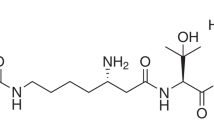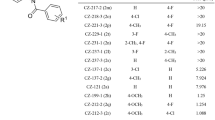Abstract
Prostate cancer (PC) is a leading cause of cancer-related death in men in Western countries. Androgen receptor (AR) signaling is a major driver of PC; therefore, androgen deprivation by medical and surgical castration is the standard treatment for patients with PC. However, over time, most patients will progress to metastatic castration-resistant PC. Enzalutamide is the only AR antagonist approved by the Food and Drug Administration for the treatment of metastatic castration-resistant PC. However, resistance to enzalutamide also develops in most patients with castration-resistant PC. Thus, there is an urgent need to develop new AR antagonists with new structures. For this purpose, we conducted both in silico and natural product screenings. From the in silico screening, we obtained T5853872 and more potent compound, STK765173. From the natural product screening, the novel compound arabilin was isolated from Streptomyces sp. MK756-CF1. Unlike STK765173, arabilin could overcome resistance to enzalutamide. Furthermore, we also extracted a novel compound, antarlide A, and its geometric isomers from Streptomyces sp. BB47. Antarlides A–F have novel 22-membered-ring macrocyclic structures, while antarlides G and H have 20-membered-ring structures. Both antarlides B and G showed potent AR antagonist activity in prostate cancer cells and could overcome resistance to enzalutamide.
This is a preview of subscription content, access via your institution
Access options
Subscribe to this journal
Receive 12 print issues and online access
$259.00 per year
only $21.58 per issue
Buy this article
- Purchase on Springer Link
- Instant access to full article PDF
Prices may be subject to local taxes which are calculated during checkout











Similar content being viewed by others
References
Fujita K, Nonomura N. Role of androgen receptor in prostate cancer: a review. World J Mens Health. 2019;37:288–95.
Heinlein CA, Chang C. Androgen receptor in prostate cancer. Endocr Rev. 2004;25:276–308.
Grasso CS, Wu YM, Robinson DR, Cao X, Dhanasekaran SM, Khan AP, et al. The mutational landscape of lethal castration-resistant prostate cancer. Nature. 2012;487:239–43.
Teo MY, Rathkopf DE, Kantoff P. Treatment of advanced prostate cancer. Annu Rev Med. 2019;70:479–99.
Gao W, Dalton JT. Expanding the therapeutic use of androgens via selective androgen receptor modulators (SARMs). Drug Disco Today. 2007;12:241–8.
Gao W, Bohl CE, Dalton JT. Chemistry and structural biology of androgen receptor. Chem Rev. 2005;105:3352–70.
Murakoshi M, Ikeda R, Fukui N. The effects of chlormadinone acetate (CMA), antiandrogen, on the pituitary, testis, prostate and adrenal gland of the dog with spontaneous benign prostatic hyperplasia. J Toxicol Sci. 2001;26:119–27.
Taplin ME, Rajeshkumar B, Halabi S, Werner CP, Woda BA, Picus J, et al. Androgen receptor mutations in androgen-independent prostate cancer: cancer and Leukemia Group B Study 9663. J Clin Oncol. 2003;21:2673–8.
Tran C, Ouk S, Clegg NJ, Chen Y, Watson PA, Arora V, et al. Development of a second-generation antiandrogen for treatment of advanced prostate cancer. Science. 2009;324:787–90.
Ning YM, Pierce W, Maher VE, Karuri S, Tang SH, Chiu HJ, et al. Enzalutamide for treatment of patients with metastatic castration-resistant prostate cancer who have previously received docetaxel: U.S. Food and Drug Administration drug approval summary. Clin Cancer Res. 2013;19:6067–73.
Claessens F, Helsen C, Prekovic S, Van den Broeck T, Spans L, Van Poppel H, et al. Emerging mechanisms of enzalutamide resistance in prostate cancer. Nat Rev Urol. 2014;11:712–6.
Watson PA, Arora VK, Sawyers CL. Emerging mechanisms of resistance to androgen receptor inhibitors in prostate cancer. Nat Rev Cancer. 2015;15:701–11.
Nelson WG, Yegnasubramanian S. Resistance emerges to second-generation antiandrogens in prostate cancer. Cancer Disco. 2013;3:971–4.
Nagamine N, Sakakibara Y. Statistical prediction of protein chemical interactions based on chemical structure and mass spectrometry data. Bioinformatics. 2007;23:2004–12.
Kawamura T, Fujimaki T, Hamanaka N, Torii K, Kobayashi H, Takahashi Y, et al. Isolation and structure elucidation of a novel androgen antagonist, arabilin, produced by Streptomyces sp. MK756-CF1. J Antibiot. 2010;63:601–5.
Zhu Z, Becklin RR, Desiderio DM, Dalton JT. Mass spectrometric characterization of the human androgen receptor ligand-binding domain expressed in Escherichia coli. Biochemistry. 2001;40:10756–63.
Tetko IV, Gasteiger J, Todeschini R, Mauri A, Livingstone D, Ertl P, et al. Virtual computational chemistry laboratory-design and description. J Comput Aided Mol Des. 2005;19:453–63.
Nagamine N, Shirakawa T, Minato Y, Torii K, Kobayashi H, Imoto M, et al. Integrating statistical predictions and experimental verifications for enhancing protein-chemical interaction predictions in virtual screening. PLoS Comput Biol. 2009;5:1000397.
Kurosawa K, Takahashi K, Tsuda E. SNF4435C and D, novel immunosuppressants produced by a strain of Streptomyces spectabilis. I. Taxonomy, fermentation, isolation and biological activities. J Antibiot. 2001;54:541–7.
Lim HN, Parker KA. Total synthesis of the potent androgen receptor antagonist (-)-arabilin: a strategic, biomimetic [1,7]-hydrogen shift. J Am Chem Soc. 2011;133:20149–51.
Steketee K, Timmerman L, Ziel-van der Made AC, Doesburg P, Brinkmann AO, Trapman J. Broadened ligand responsiveness of androgen receptor mutants obtained by random amino acid substitution of H874 and mutation hot spot T877 in prostate cancer. Int J Cancer. 2002;100:309–17.
Bohl CE, Gao W, Miller DD, Bell CE, Dalton JT. Structural basis for antagonism and resistance of bicalutamide in prostate cancer. Proc Natl Acad Sci USA. 2005;102:6201–6.
Korpal M, Korn JM, Gao X, Rakiec DP, Ruddy DA, Doshi S, et al. An F876L mutation in androgen receptor confers genetic and phenotypic resistance to MDV3100 (enzalutamide). Cancer Disco. 2013;3:1030–43.
Igarashi Y, Yu L, Ikeda M, Oikawa T, Kitani S, Nihira T, et al. Jomthonic acid, a modified amino acid from a soil-derived Streptomyces. J Nat Prod. 2012;75:986–90.
Saito S, Fujimaki T, Panbangred W, Igarashi Y, Imoto M. Antarlides: a new type of androgen receptor (AR) antagonist that overcomes resistance to AR-targeted therapy. Angew Chem Int Ed Engl. 2016;55:2728–32.
Saito S, Fujimaki T, Panbangred W, Sawa R, Igarashi Y, Imoto M. Antarlides F-H new members of the antarlide family produced by Streptomyces sp. BB47. J Antibiot. 2017;70:595–600.
Kato Y, Scheuer PJ. Aplysiatoxin and debromoaplysiatoxin, constituents of the marine mollusk Stylocheilus longicauda (Quoy and Gaimard, 1824). J Am Chem Soc. 1974;96:2245–6.
Chlipala GE, Pham HT, Nguyen VH, Krunic A, Shim SH, Soejarto DD, et al. Nhatrangins A and B, aplysiatoxin-related metabolites from the marine cyanobacterium Lyngbya majuscula from Vietnam. J Nat Prod. 2010;73:784–7.
Wang CZ, Maier UH, Keil M, Zenk MH, Bacher A, Rohdich F, et al. Phenylalanine-independent biosynthesis of 1,3,5,8-tetrahydroxyxanthone. A retrobiosynthetic NMR study with root cultures of Swertia chirata. Eur J Biochem. 2003;270:2950–8.
Smith MR, Antonarakis ES, Ryan CJ, Berry WR, Shore ND, Liu G, et al. Phase 2 study of the safety and antitumor activity of apalutamide (ARN-509), a potent androgen receptor antagonist, in the high-risk nonmetastatic castration-resistant prostate cancer cohort. Eur Urol. 2016;70:963–70.
Moilanen AM, Riikonen R, Oksala R, Ravanti L, Aho E, Wohlfahrt G, et al. Discovery of ODM-201, a new-generation androgen receptor inhibitor targeting resistance mechanisms to androgen signaling-directed prostate cancer therapies. Sci Rep. 2015;5:12007.
Borgmann H, Lallous N, Ozistanbullu D, Beraldi E, Paul N, Dalal K, et al. Moving towards precision urologic oncology: targeting enzalutamide-resistant prostate cancer and mutated forms of the androgen receptor using the novel inhibitor darolutamide (ODM-201). Eur Urol. 2018;73:4–8.
Liu N, Zhou W, Guo Y, Wang J, Fu W, Sun H, et al. Molecular dynamics simulations revealed the regulation of ligands to the interactions between androgen receptor and its coactivator. J Chem Inf Model. 2018;58:1652–61.
Acknowledgements
Work on new AR antagonists at Keio University was funded by a grant program for bioinformatics research and development of the Japan Science and Technology Agency, grants from the Ministry of Education, Culture, Sports, Science and Technology of Japan (MEXT KAKENHI Grant Number JP23102006 and JSPS KAKENHI Grant Number JP15H03116 to MI).
Author information
Authors and Affiliations
Contributions
M.I. supervised this review article. T.F, S.S and E.T. wrote this review article.
Corresponding author
Ethics declarations
Conflict of interest
The authors declare no competing interests.
Additional information
Publisher’s note Springer Nature remains neutral with regard to jurisdictional claims in published maps and institutional affiliations.
Rights and permissions
About this article
Cite this article
Imoto, M., Fujimaki, T., Saito, S. et al. Androgen receptor antagonists produced by Streptomyces overcome resistance to enzalutamide. J Antibiot 74, 706–716 (2021). https://doi.org/10.1038/s41429-021-00453-y
Received:
Revised:
Accepted:
Published:
Issue Date:
DOI: https://doi.org/10.1038/s41429-021-00453-y
This article is cited by
-
Development of a drug discovery approach from microbes with a special focus on isolation sources and taxonomy
The Journal of Antibiotics (2023)



